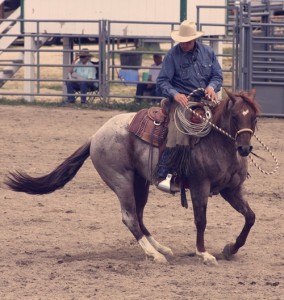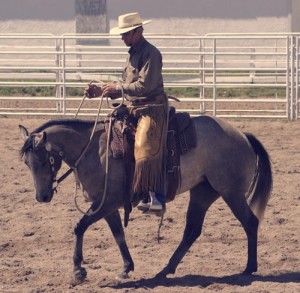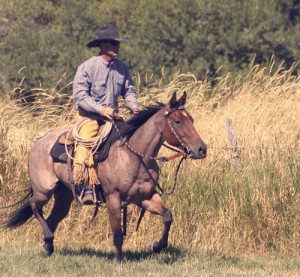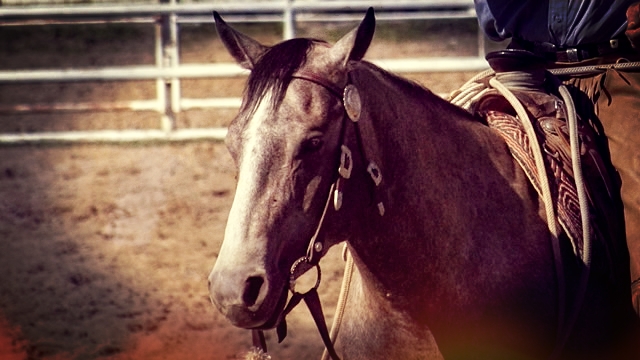Round Table Discussion with Martin Black, Buck Brannaman, and Bryan Neubert.
This article originally appeared in issue #81 – Jan/Feb 2015 issue of Eclectic Horseman Magazine. Learn how to subscribe.
Often people use either the snaffle bit or the hackamore when putting the first few rides on a colt, but is one a better choice than the other? Are there pros and cons to consider for each? It’s a topic that seems to be getting kicked around horse circles quite a bit recently as many people look to clinicians, articles, videos, trainers, and the Internet for answers to provide youngsters the best possible start under saddle.
Here we’ll visit with three of America’s prominent horsemanship clinicians who are familiar to Eclectic Horseman readers to get their opinions on the subject. We hope their thoughts will provide useful insights on the issue of whether to use one or the other of these devices when starting horses, and that the discussion helps folks in general to think in ways that above all consider the horse.
Bryan Neubert

I started my first horses by myself, and then Bill Dorrance was my neighbor and he helped me start some. We started everything in the snaffle bit. And then he got me a job with a friend of his named Ray Hunt. I worked for him four times. The first two times we started horses, just him and I, and we started everything in the snaffle bit—first rides in the snaffle bit. Then Ray took off and started doing the clinics. He had everybody starting them in the halter, and I said, “What’s the deal there?”
He said, “I can not get them to quit pulling on them for a security blanket. They about pull these horses over. These colts have no idea about a snaffle bit—they’ve never had anything in the mouth but food—and now they’ve got somebody on their back for the first time and the person wants to use that bit for a security blanket.”
But, it’s a little bit like throwing gas on the fire because the horse has enough to consider, and now he’s got some pressure in his mouth that he has no understanding about.
So he said, “It’s just easier for me—I’ve been just having them ride them in the halter. But people still just rear back on the reins on the halter and some of them have been pulling them clear over backwards.”
I thought, “Gee wiz, he can’t get these people not to use their reins for security.”
There in the late 70s he even went through a little deal where he had them ride their colts for the first time with nothing in their hands. I don’t think I saw one of those, but my cousin was telling me—there in Montana, “There was only 10 colts and he just opened the gate on us with nothing on their heads and we didn’t even get 15 feet and three people hit the ground right there.”

I think he abandoned that and went back to the one-rein with the halter deal. I went through a spell where I was using one rein with the halter, and then two reins with the halter, and then I got to thinking, “Well, how come you’re doing this? This really is not necessary.”
I’d use that if I have kind of a scary one to start, and I knew he was probably going to get up and go when you got on. If I had him broke to lead and handle with a halter, then probably it would make more sense to him than a bit in his mouth. So that’s what I did for awhile, but then, “Why would you do this if they’re not real scary?” So the ones that I didn’t think would get that upset, I’d just start them in the snaffle bit.
When I was younger, like [working with] wild horses, just using a little too much snaffle bit, they didn’t understand it. I wasn’t recognizing their efforts and backing the pressure off to encourage them to yield, and sheesh, I’ve had some of them older horses I mean striking at their ears. I was just a kid, but it’s like throwing gas on the fire, and if they don’t know what a snaffle is, you better take it one little bitty piece at a time or else you’re going to be in trouble.
I’ve started them in the hackamore, too. It’s not too different from a halter. I think it’s just fine. You hear people say, “I want to protect their mouth.” I think to myself, “What are you protecting it from?” If you think riding him in the hackamore is protecting his mouth, it makes me wonder how you’re handling your snaffle bit.
If it’s going to be a tug of war—you’re going to try to out muscle him—then I’d say his mouth could use a little protecting from you. But if you are considerate of his efforts, I mean the slightest effort that he could put out, by considerate I mean ease off pressure when he even thinks about yielding, there’s nothing to protect his mouth from. He should stay pretty light. If you had a hackamore on there and you’re pulling for all your worth without considering his efforts to comply, he’s going to get a pretty hard nose.
I’ve started a lot of them in the hackamore and I like that too, I don’t know if I like it any better—it’s just something different. Really, whether you’re starting him in a snaffle bit or a halter or a hackamore, your success is going to be based on how keen you are at recognizing and rewarding the slightest effort.
When I asked Bill Dorrance that: snaffle bit, hackamore, and all that—and I’m pretty sure Tom Dorrance and Ray Hunt would probably have the same answer— it wouldn’t matter too much what you had. It matters quite a bit more about how you handle what you have.
Buck Brannaman

That’s become all the rage now, starting the horse in the hackamore. Traditionally the vaqueros used both. It’s almost become a bit of a fad, and that’s all fine. My answer is, I’m a student of Ray Hunt and Tom Dorrance, and that’s what they did, and I think I’d be pretty self-indulgent to think that I’m going to improve on what Ray Hunt and Tom Dorrance were doing. I’m doing my best to fulfill my promise to Ray that I was going to take what he taught me and try to do it as well as I could. I’m not trying to reinvent the wheel or look like the greatest genius to come down the pike. They started in a snaffle, went to the hackamore, went to the two-rein, went to the bridle—that was the tradition that I was taught by Ray Hunt and Tom Dorrance, and I stick to that.
There’s some technicalities: snaffle bit versus a hackamore starting a horse. If your plan in starting a horse is eventually to end up to do classical movements in the bridle bit, there are things that you can do in a snaffle bit on a green horse in terms of haunches in, shoulders in, half pass, backing circles properly—all of those things, you’re combining lateral and longitudinal flexion, creating movement of the pole joint, between the pole joint and the atlas. Those sort of complex flexions are required in classical riding and typically people who now-a-days are starting horses in a hackamore, most of the movements that they ultimately end up with are fairly primitive movements. It is not classical riding. They still may be able to stop, turn around, change leads, and may be good to work a cow, good to rope on, but in terms of the end goal, if you’re looking for true classical movement in proper form—and I’ve made a gillion hackamore horses—it is very difficult to have complex flexions as an end result if you didn’t introduce it in the snaffle.
At this stage in my life, could I get all those flexions in the hackamore now without using the snaffle? Yes, I sure could. But I’ve made a lot of hackamore horses.
There’s another price to pay if you don’t start a horse in a snaffle bit, and that is, then when you go to the two-rein, the first bit he ever has in his mouth is a bridle bit and he’ll be real busy in the mouth because that’s the first bit he ever wore. He’ll run that cricket until it makes you crazy.

Some people will say, “The sound of a horse running a cricket sounds like music to me.” Well, to me, the most beautiful song I ever heard, after I heard it 10,000 times, I hate. It’s not music, it’s agitation and trouble. You should only occasionally hear a horse run the cricket and it’s to lubricate his mouth when he’s pushing his tongue forward and back. He’s lubricating his mouth and the mouth should go quiet again. Running a cricket the entire time, you have a troubled horse; you might as well own it. So, that’s the problem if he’s never worn a snaffle bit and he just got started in a hackamore because that was the fashion of the time, the first bit he ever has is a bridle bit and it’s going to take him a long time to get quiet in the mouth as a result of that.
You can have right-to-left flexion in a horse’s neck, and you can have vertical flexion at the poll, but as far as getting the poll to roll right-to-left with the presence of vertical flexion, if you don’t get that in a snaffle, you’re probably not going to get it in a hackamore. There’s a big difference between a horse bending their neck right or left and rolling their jaw under their neck. That was the word Ray used to use, and that references the poll moving right to left while in vertical flexion. That’s classical flexion and if a person was trained to look for that, you’d see how many people don’t actually get that. In that they can separate lateral and longitudinal—that’s how you teach it, lateral first then longitudinal. Then you start to combine the two flexions while in movement. That’s something that can easily be separated for a horse because of the way a snaffle bit operates.
A lot of people who are going to start a horse in a hackamore, they’re going to be happy if he’s obedient and quiet and can turn and stop and back up and maybe lope a circle—that may be all they’re looking for. But that isn’t enough to satisfy my goals in riding.
Martin Black
I think the thing to address is not what equipment is on the horse’s head but rather the hands handling the equipment. The snaffle bit, in my opinion, puts more responsibility on the horse. The hackamore puts more responsibility on the person.

I don’t think a lot of people are aware of the damage that a snaffle bit causes to the bars of the mouth and, at the very least, the pain that it causes in the early stages. I have seen plenty of horses with bruises or calluses on the bars of their mouth from a snaffle bit when the people riding them were completely unaware they were causing this type of damage.
Most of us would like to deny it, but it speaks for itself if you know what to look for. It’s pretty hard to start a horse in the snaffle bit or do much correcting without causing some tissue damage. When the mouthpiece bumps the bar, the horse’s head is going to go up and he’s basically saying “ouch.” That’s a mild case. The next day you may see the tissue damage. Sure, there’s ways around this. I’m not saying every experience ends up this way, just a lot more than what people are aware of. On the other hand, what I find interesting is when a horse is ridden in a hackamore and has any hair rubbed off or tissue damage, people are very aware and often make an issue of that, whereas with the snaffle bit it’s “out of sight out of mind.”
People may start their horse in a halter, and the horse learns a lot being ridden in the halter along with the groundwork with a halter. They can learn to respond very well to the halter, which isn’t that much different than a hackamore although a lot of people make a big distinction between the two. The biggest difference that I see is that the weight of the hackamore gives it more feel and signal than the halter.
My question is, if you ride them in the halter or hackamore at first to save their mouth, why are you going to the snaffle bit later on?
Some people are going to hang on them, or pull too hard, and build resistance and get in trouble because of that, so they go to the snaffle bit to get the horse more responsive.
The easy thing is to change bridles; the hard thing is to change the presentation of our hands. This is what I enjoy about the hackamore. I think it improves the hands of the rider, and for whatever reason they choose to ride in the snaffle later, it only makes their hands better with a snaffle bit. There’s no question if you have good hands with a hackamore, you’ll be fine with the snaffle bit. But it doesn’t always work the other way around. But without learning the ability to keep the horse good in a hackamore, I don’t think you ever really learn to improve your hands to make a good horse in a snaffle bit.

My feeling is, if you’re really interested in your horsemanship and you want to work on yourself, the hackamore is going to teach you more. It’s going to force you to be better because you can’t put the responsibility on the horse. Anytime you’re pulling steady or too hard the horse can refuse you, and then you have to make a note to yourself, “Okay, I need to have my hands better, out more, more life, not a dead steady dragging feel.”
Think about the horses pulling a stagecoach, driving horses. They could not be handled with hackamores. We know what would happen. That’s why we have bits in their mouth. You can’t get your hand out to the side or have much feel and timing with a horse with the lines coming back to the hames—it’s that steady dragging pull. That’s pretty much the same feel that a lot of riders offer their horse, not much feel or timing. But that’s how a lot of riders are instructed, to keep their hands pulling toward their hip and hold pressure until the horse gives to the pressure.
Again, the hackamore is going to force you to find more timing and feel for the horse to follow. Learning to ride with a hackamore just teaches you how to make a horse better with a snaffle bit.


